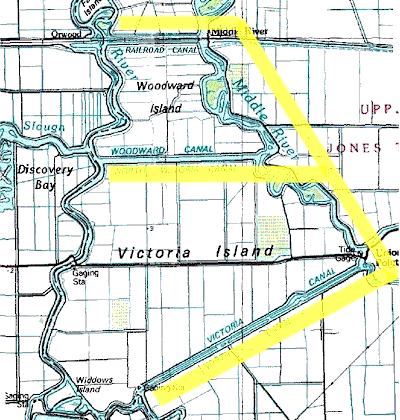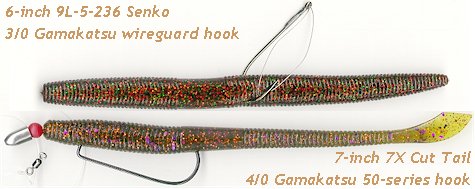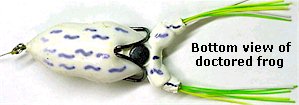The Dozer on the Delta
 This April, I
fished Central
Florida's Stick Marsh for bass. In May, I worked Northern
California's Delta five days with friends Mark Mendez, Alton
Forthe and Long Nguyen, principals of U.S. Angler's Choice, the world's largest
team fishing tournament organization. I pre-fished one day with
Alton, one with Long, two with Mark. We pitched, flipped and
dipped the tule berms for twenty to thirty-five bass every day.
It all led up to the fifth day when we held a miniature two boat
tournament. I drew Long as my partner versus Mark and Alton. Our
best five during the mini-tournament weighed 17 lbs 7 oz.
I'm telling you exactly how we did it Delta Style if you follow
me to... This April, I
fished Central
Florida's Stick Marsh for bass. In May, I worked Northern
California's Delta five days with friends Mark Mendez, Alton
Forthe and Long Nguyen, principals of U.S. Angler's Choice, the world's largest
team fishing tournament organization. I pre-fished one day with
Alton, one with Long, two with Mark. We pitched, flipped and
dipped the tule berms for twenty to thirty-five bass every day.
It all led up to the fifth day when we held a miniature two boat
tournament. I drew Long as my partner versus Mark and Alton. Our
best five during the mini-tournament weighed 17 lbs 7 oz.
I'm telling you exactly how we did it Delta Style if you follow
me to...
California's Delta is a sprawling mass of rivers, sloughs
and cuts - about 1,000 miles of navigable waterways fed by
five major rivers including the Sacramento River and the San
Joaquin River. Click here to view a sprawling California Delta map
page.
The Delta was simply a wide open expansive freshwater estuary
until the late 1800's But beginning then and through the
1900's farmers dredged canals and constructed levee walls,
impounding and draining fertile agricultural islands nestled
behind the thick mud levee walls they armored in riprap rock.
Overall some fifty fertile man-made agricultural islands were
constructed and drained. The farm islands, often called tracts,
sit below sea level on the other side of the levees we were
fishing. The stout levees hold the Delta water back from flooding
these island farms which were once the estuary bottom.
 We mostly
fished the southern section of the Delta along the Middle River,
Victoria Canal, Woodward Canal and a railroad canal. The stout
earthen levee walls sport an outer shell of heavy riprap stones
to protect the levees against erosion. Every several hundred
yards along the rock walls, tule berms rooted in peat intruded
into the canals. These tule berms on rock walls were the
key to most of the bass we caught for five days. We mostly
fished the southern section of the Delta along the Middle River,
Victoria Canal, Woodward Canal and a railroad canal. The stout
earthen levee walls sport an outer shell of heavy riprap stones
to protect the levees against erosion. Every several hundred
yards along the rock walls, tule berms rooted in peat intruded
into the canals. These tule berms on rock walls were the
key to most of the bass we caught for five days.
Not every tule berm held bass. Three out of every four
berms were just not productive. As we worked down the long walls
of berms, we'd keep tabs of which one or two berms produced bass.
Usually, if a berm held one bass, it held many. But the majority
of berms, although they looked identical, were unproductive as we
fished through them. Who knows why? After fishing through eight
to ten berms in a row, we'd often motor back to re-fish the one
or two berms that held bass ~ and catch a second helping of
several more bass on the second pass through the productive
berms.
The tule is a beautiful, perfectly smooth-skinned stalk of
tall bulrush native to northern California estuary lowlands. Many
Delta tule berms were already higher than ten feet tall in early
May, and grow much taller later in the season. Because of the
perfectly smooth hard skin, tules are ideal for pitching and
flipping with minimal hang-ups.
Other berms of tall grasses lined the banks too. Vast weed
beds of abrasive line-cutting phragmites, dense walls of tall
woody bamboo grass berms. Some banks were overhung with woody
brush and tree tangles. However the bass we caught were mostly
only in tule berms having rock walls behind them. The prime
producers, the best tule beds had outer matted grass beds running
the length of the berms, with about a three to six foot wide
channel about three to six feet deep between the tule berms and
the outer grass beds. These channels were kept open by the moving
tide flowing slowly between the grass beds and the tules.
However, the sections we fished had more of an up and down
tidal effect rather than a back and forth effect. Still, the
wind and tide induced currents were enough to keep the channels
open between the tule berms and the outer grass beds. These tule
berms on rock walls with channels running lengthwise between the
tules and the outer grass beds were the key to most of the
bass we caught for five days.
During the five days, the Delta held a brown dirt stain.
Darker in some places, lighter in other areas, but always brown
dirt color. Alton, Long and Mark mainly fished wacky weightless
five-inch 9-series Senkos. In the very darkest brown water, they
opted for darker 051, 021 or 213 shades. Where the brown stain
was lighter, more naturals were used like 208, 914 and 916. As
for myself, for five days I threw two lures only, and essentially
only one color. I never needed to try another lure. The bass
were on these baits for five days:
1.) First, a six-inch 9L weightless wacky-rig
Senko (color 236) on a 3/0 Gamakatsu wire guard hook when the
water was high and/or the wind was low.
The 9L Senko and 236 color were recommended by Team Yamamoto
pro Andy "Cooch" Cuccia, The 236 color matched the
brown dirt stain of the Delta water. In deep holes and high water
and/or when the wind was moving the boat slowly enough to take
advantage of its slow horizontal fall, the weightless wacky 9L
was the ticket. Rigged wacky, the 9L Senko weighs 1/2 oz
weightless and wriggles down naturally into the open holes
between the tules rather than plunging down nose first as with an
added weight.
2.) Second, a seven-inch 7X Texas-rigged Cut
Tail (a non-stock color quite similar to 236) weighted with 1/8
to 5/16 bullet sinkers when the water was low and/or the wind
was high.
As the wind gusted the boat down the berm banks, the drift
could quickly become too fast for the slow weightless fall of the
9L Senko to be effective. At times we zipped along barely being
able to keep the bait in a spot more than several seconds. And in
low water, the bass were pulled back deeper inside the tule berms,
hunkered under floating mats of dead straw. The weightless wacky
Senko was ineffective to break through the floating straw at low
water, but just perched atop the flotsam. Yet the 7X Cut Tail
Texas-rigged with a light bullet sinker on its nose (from 1/8 to
5/16 oz based on wind speed) slipped down between the straws
easily. Each evening, I pre-tied a few of what I call "Texas
Twist" rigs for the next day, using an 80 lb test SPRO
swivel, 12 inches of 20 lb test fluorocarbon leader line,
tungsten bullet sinker, rattling red beads and 4/0 Gamakatsu
50-series hooks. This style hook excels in heavy cover. Perhaps a
screw-in Florida sinker may have worked as well or better, but I
did not try it. I felt the Texas twist rig preserved some of the
free-falling action of an unweighted Cut Tail. It kept the sinker
sliding a foot away from the bait. On bottom contact, the weight
would bury itself in the bottom grass, but the Cut Tail would
come to rest attractively atop the grass without being pulled
down inside the grass as with a screw-in Florida rig.
At first, one may be a little skeptical of the extra added
length of the 7X Cut Tail, but the size doesn't deter bass one
bit. Although seven inches, the 7X Cut Tail compares closely in
shape to the standard 5" Senko. The extra length is
deceptive as it is only longer in the very slender cut tail.

With either weightless wacky Senkos or
Texas-rigged Cut Tails, if you simply pitched to open water in
front of the tules, the bait would pendulum fall too far out from
the cover to be effective during these five days on the Delta. It
helped to pitch the bait so it draped over one or two stalks back
into any spot. In this way, the bait would swing back into the
thick cover where bass whacked it.
The hard-packed dense clumps of tules were higher
percentage spots for this trip. Loosely-packed tule clumps or
spread-out tule beds did not seem to harbor hardly as many bass
as did the densest, hardest-packed tule clumps in the berm.
As we fished together and our time together drew
to an end, huge seals swam crisscrossing patterns in the slough
channels at sundown, seeking to intercept salmon or striped bass
they'd bite then head-toss up into the air to keep their meal
from swimming too far away between bites. As we drifted down the
berms, pudgy brown beavers tanned like Delta kings on straw beds
they fashioned in the tules, us flipping and pitching Cut Tails
all around the unfazed fellows' lairs, and raccoons light-toed
trails barely wide enough for them to travel the shoreline edge
in the overhanging underbrush of the place the northern
California bassmen call their Delta home.
| Trip Checklist
~ WHAT WE USED |
1 Pitching & Flipping Rod ~ 16
to 25 lb test fluorocarbon baitcasting
9-series Senkos ~ 9L-series Senkos ~
7X-series Cut Tails
021 Black w/blue
051 Black w/red
208 Watermelon w/black & red
213 June bug purple w/emerald
236 Root beer w/green & copper
914 Watermelon amber w/black tail coreshot
916 Watermelon w/purple & copper (7X field test)
|
1 Frog Rod ~ 65 lb test
Power Pro braided line
Snag Proof Tournament Frog
White with hand-drawn black belly markings
|
Terminal Tackle
3/0 Gamakatsu straight shank wireguard worm hooks
4/0 Gamakatsu 50-series offset round bend worm hooks
1/8 to 5/16 oz tungsten Texas bullet sinkers
SPRO 80 lb swivels, 6 mm red rattling beads, 20 lb fluorocarbon
leader line
|
A solid Snag Proof frog bite developed during the hotter
windless afternoon moments. In high school many of us may have
dissected frogs in bio lab class, but Delta frog doctors perform
advanced procedures to surgically alter their frogs. We now end
this odyssey on the Delta as frog-doctor Long Nguyen documents
the steps necessary to operate.
Dissecting a Delta Frog by Long Nguyen
We've all dissected frogs in biology lab in high school. Most
of us may never doctor another frog again, unless of course that
frog is a Snag Proof tournament frog commonly used on the Delta.
Read on as frog doctor Long Nguyen explains some of the surgical
procedures to make a good frog even better.
Snag Proof Tournament frogs work great right out of the
package, but if you make a few changes, they'll work even better,
says Long. Popular thinking a few years back was the notion you
had to have matted vegetation plus sweltering heat in summer in
order to catch bass using the tournament frog. True, you can have
torchin' top water action when the weeds mat over and the sun
blisters, but then you'd be missing out on the effectiveness of
the frog in open water outside the summer months...such as right
now!
The modifications I do to my frog enable me to walk my frog
like a Zara Spook. Best of all, I can reach for the frog in small
open water areas where a Zara Spook or buzzbait is ineffective,
such as a small open water pocket up against shore behind a weed
bed or in super shallow water.
I keep a clear distinction between doctoring my 1.) pre-summer
frogs for open water and 2.) summer frogs for thick matted weeds.
Typically, a modified "walking" frog for open water
sits higher on the surface due to the lack of any additional
weight, yet still enables me to make long distance casts directly
over heavy cover and into open water pockets without fear of
snags. On the other hand, a "mat" frog intended for
thick matted summer grass is usually weighted down and includes
rattles. The extra added weight and rattles help when you are
pulling your bait across thick clogs of matted vegetation, the
weight and rattles emit a huge presence in the thickly-matted
summer grass.
Why the Frog?
But for now, before summer arrives, I reach for the frog where
I want a topwater presentation, yet a traditional topwater bait
like Zara Spook or buzzbait is ineffective due to sparse cover
that would catch on the buzzbait or Spook but not on the frog.
Here on the California Delta, I've caught frog fish in super
shallow, weed filled water, just enough to cover their backs. In
such situations, the frog makes the better presentation because
of its resistance to snags, soft entry into the water, and a
subtle action. Keep in mind that with a long distance cast, a
frog plops, floats and can be played a long time bumping up
against the weed edge. On the other hand, a buzzbait would crash,
sink, require a few feet of line retrieve before it rises to the
surface, and clog up against the weed edge. A Zara Spook would
snag every weed between the boat and the distant open water
pocket. Hence the effectiveness of the frog.
Frog Rod, Reel, Line
My frogging set-up is stout. Very. Typically, any stout
casting rod matched with a reel capable of holding 100 yards of
65 lb test Power Pro will work for frog fishing. Some froggers
make a distinction between an open water frog rod versus a mat
frog rod. Ideally, an open water frog rod should be a little more
forgiving to allow precision roll casting. It also allows the
bait to be sucked into the fish's mouth easier, and a softer rod
allows the frog to walk easier. However, the rod should
immediately load into pure backbone to pull fish out of the nasty
places.
As a compromise for both mats and open water frog fishing, I
use a 5-power rod, a G. Loomis MBR 845 GL3 rod, a Shimano Curado
200 reel loaded with 65 lb Power Pro braided line. This
particular setup allows me to make super long distance casts, yet
still set the hook hard into bass embedded deep in weed cover
with no line stretch. It's also relatively light, so I can fish
this bait all day if necessary without fatigue.
Give Credit
I have to credit Snag Proof sponsored tournament pro Mark
Naillon for showing me some of these modifications, along with
froggin' expert and Snag Proof pro Bobby Barrack. Bobby made
popular marking up the belly of the frog with the use of a black
Sharpie Felt pen. I have followed suite as a student of their
techniques, and have the utmost respect for these truly
innovative frog fishing experts.
Tools of the Trade
 My frog modifications
are relatively simple and require the use of (1) scissors, (2)
super glue, (3) black felt pen (4) Gamakatsu EWG replacement
Double Hook and (5) a split ring. I have seen other anglers take
it a few steps further by changing out the rubber legs for
silicone skirts, longer rubber skirts, feathers, and even Senkos
and single tail grubs as frog legs. My frog modifications
are relatively simple and require the use of (1) scissors, (2)
super glue, (3) black felt pen (4) Gamakatsu EWG replacement
Double Hook and (5) a split ring. I have seen other anglers take
it a few steps further by changing out the rubber legs for
silicone skirts, longer rubber skirts, feathers, and even Senkos
and single tail grubs as frog legs.
Trimming the Fat
Eighty-percent of the time I'm throwing a white frog, so my
modifications revolve around this bait color. Adding a split ring
to the nose helps the frog swing freely side-to-side while it is
walking the surface. I've found this really helpful rather than
tying directly onto the nose of the bait. Replacing the stock
hooks with the Gamakatsu EWG Double Hook is also a requisite
step. The Gamakatsu EWG replacement hook balances well with the
bait and does not add too much additional weight which would
affect the walking action.
But the single most important modification that impacts the
action of the frog is to trim the rubber legs. The bait comes
standard with 30 or so strands of rubber on each leg. With
scissors, trim down to about 6 strands per side. By the time I'm
done, the 6 remaining strands will be directly in the center of
the rubber. In other words, I cut from the outside in, only
leaving 6 strands in the center. I cut them as closely as
possible to the frog body, taking extreme care not to cut more
than 2 or 3 strands at a time.
Once I've cut down to 6 strands, I carefully take super glue
and glue the face and sides of where the rubber was trimmed to
the plastic of the frog using extreme caution. By gluing the base
of the cut rubber legs, it keeps the rubber skirt from pulling
out the other side. Use caution when applying the glue! I've
accidentally glued the 6 strands together, and destroyed the
bait. You need to keep the strands moving freely! Only glue the
base of the rubber strands where you trimmed them, and not on the
legs themselves. Hang the bait to dry, and you're set to go
froggin' on the Delta. ~ Long Nguyen
| If You Go ~
CONTACT INFORMATION |
Cooch's Fishing Guide Services
Captain Andy Cuccia ~ Tel. 925-609-5148
FlipBiguns@Yahoo.com
|
California Delta Guide Services
Captain Gary Dobyns ~ Tel. 530-671-1989
|
Angler's Cove Tackle Shop ~ Big
Break Marina
Tel. 800-706-4880
support@anglers-cove.com
|
Hook, Line & Sinker Tackle Shop
Gene Buchholz, Owner ~ Tel. 925-625-2441
Hookline@sbcglobal.net
|
|
